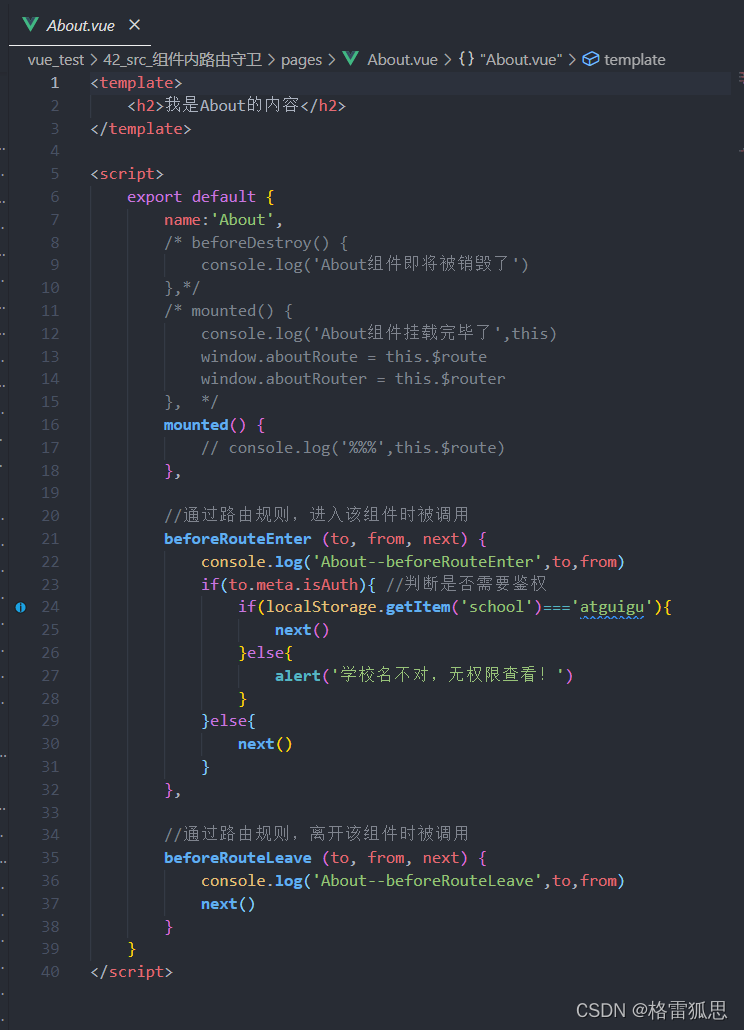路由守卫
作用:对路由进行权限控制
路由守卫可以给开路由添加权限判断,例如
用户未登录就不能去某个页面,登录之后可以去到一些页面
如下:
-
to:要跳转到的路由目标
-
from:从哪里跳转的路由 来源
-
next:函数体 必须要next()才会让路由正常地跳转和切换,next(false)在原地停留,next(“强制修改到另一个路由路径上”)
注意:一定要调用next,如果不调用next,那么页面不会跳转的
全局路由在真正跳转之前,会执行一次beforeEach函数,next调用则跳转,也可以强制修改要跳转的路由
router.beforeEach((to,from,next) => {
//路由跳转“之前”先执行这里,决定是否跳转
let isLogin = false; //未登录
if (to.path === '/center' && isLogin === false) {
this.$message.success("请登录")
next(false) //阻止路由跳转
}else {
next() //正常放行
}
})
-
全局守卫:
//全局前置守卫:初始化时执行、每次路由切换前执行 router.beforeEach((to,from,next)=>{ console.log('beforeEach',to,from) if(to.meta.isAuth){ //判断当前路由是否需要进行权限控制 if(localStorage.getItem('school') === 'zhejiang'){ //权限控制的具体规则 next() //放行 }else{ alert('暂无权限查看') // next({name:'guanyu'}) } }else{ next() //放行 } }) //全局后置守卫:初始化时执行、每次路由切换后执行 router.afterEach((to,from)=>{ console.log('afterEach',to,from) if(to.meta.title){ document.title = to.meta.title //修改网页的title }else{ document.title = 'vue_test' } })
实例
// 这个文件专门用于创建整个应用的路由器
import VueRouter from 'vue-router'
// 引入组件
import About from '../pages/About.vue'
import Home from '../pages/Home.vue'
import News from '../pages/News.vue'
// 创建并暴露一个路由器
const router = new VueRouter({
routes: [
{
path: '/home',
component: Home,
meta:{
title:'主页'},
children: [
{
path: 'news',
component: News,
meta:{
isAuth:true,title:'新闻'}
}
}
]
},
{
path: '/about',
component: About,
meta:{
title: '关于' }
}
]
})
// 全局前置路由守卫————初始化的时候被调用、每次路由切换之前被调用
router.beforeEach((to, from, next) => {
console.log('前置路由守卫', to, from);
if(to.meta.isAuth) {
if(localStorage.getItem('token') ) {
// 放行
next()
} else {
alert('没有登录,无权查看')
}
} else {
next()
}
})
// 全局后置路由守卫————初始化的时候被调用、每次路由切换之后被调用
router.afterEach((to, from) => {
console.log('后置路由守卫', to, from)
document.title = to.meta.title || '我的系统'
})
export default router
- 独享守卫:
就是在 routes 子路由内写守卫
beforeEnter(to,from,next){ console.log('beforeEnter',to,from) if(to.meta.isAuth){ //判断当前路由是否需要进行权限控制 if(localStorage.getItem('school') === 'atguigu'){ next() }else{ alert('暂无权限查看') // next({name:'guanyu'}) } }else{ next() } }
- 组件内守卫:
//进入守卫:通过路由规则,进入该组件时被调用
beforeRouteEnter (to, from, next) {
},
//离开守卫:通过路由规则,离开该组件时被调用
beforeRouteLeave (to, from, next) {
}

